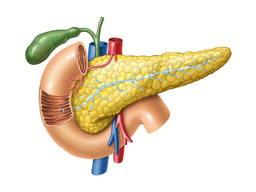New Oral Drug Strategy for Targeting Pancreas
TECHNOLOGY NUMBER: 2021-411

OVERVIEW
A novel approach for delivering drugs to the pancreas using microparticles- Concurrent use with agents that open the caliber of the Sphincter of Oddi
- Improves diffusion and accumulation of chemotherapy agents in the pancreas
BACKGROUND
Pancreatic cancer accounts for 3% of all cancer diagnoses and approximately 7% of all cancer deaths in the United States. Patients commonly present with tumors that are too advanced to allow for successful surgery, and the most commonly administered chemotherapy agents unfortunately reach the tumor tissue at a rate of less than 1%. Therapeutic agents such as gemcitabine chemotherapy, which is typically employed to treat pancreatic cancer, yield 5-year survival rates of less than 10%. Moreover, delivery of intravenous chemotherapy is labor intensive for healthcare providers as well as being time-consuming and toxic for patients. While oral chemo-drug formulations have been utilized, this approach is mainly used either for systemic absorption of drug molecules or for mucoadhesive binding of drug carriers onto the intestinal wall. Therefore, there is a need for effective pancreatic cancer therapeutics that have minimal off-target toxicity, that show increased efficacy, which have ease of use, and that can be orally administered.
INNOVATION
Researchers present a novel strategy for delivering drugs to the pancreas which consists of micro-sized particles that can be orally administered to deliver chemotherapy agents safely and effectively. The technology takes advantage of the opportunity to employ the opening that connects the pancreatic duct to the duodenum, known as the Sphincter of Oddi, as a portal for drug delivery. The chemotherapy-loaded microparticles are seen to accumulate at higher levels in the pancreas compared to existing delivery methods, presumably because the presence of pancreatic neoplasm increases the caliber of the opening of the Sphincter of Oddi. And researchers have also calculated that microparticle-loaded chemotherapy given concurrently with agents known to relax the Sphincter of Oddi improve diffusion and accumulation of the anti-neoplastic drugs through the pancreas.
The researchers therefore envision the option for oral delivery of drugs that can better target pancreatic tumors and decrease the negative effects of chemotherapy on other organs. This technology may additionally be useful for treating benign diseases associated with the pancreas, including pancreatitis and diabetes. Since the Sphincter of Oddi also controls the common bile duct, one may also envision that this approach could deliver drugs through the common bile duct to target the gallbladder and liver.